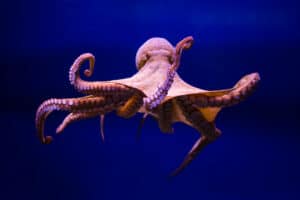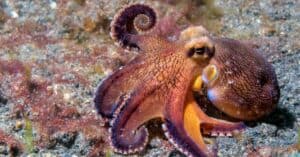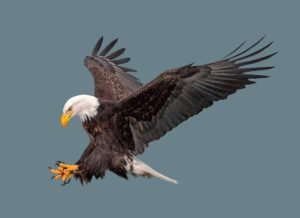Key Facts
- With a name that means “eight legs” in Greek, octopuses are some of the most intriguing forms of marine life on the planet.
- Cousins to cuttlefish and squids, octopuses also vary in size with the smallest of them measuring just 2 inches and the largest of them measuring 18 feet. Giant Pacific octopuses are the biggest octopus in the world.
- Other than their vast variation in size, octopuses also have a surprising number of qualities with some able to change their color at will and others able to release clouds of ink to deter predators.
Equally mysterious and beautiful, octopuses are captivating creatures. There are over 300 species of octopus, and they thrive in every ocean and habitat. Their soft bodies can rapidly change shape, shifting from small to large within moments. Their nervous system and brain function are among the most complex found in any invertebrate. Octopuses come in all shapes and sizes, but which type is the biggest octopus in the world? By examining their length and weight, it’s easy to determine which of these eight-limbed cephalopods is the largest of them all. Here are the ten largest octopuses in the world.
#10: Dumbo Octopus
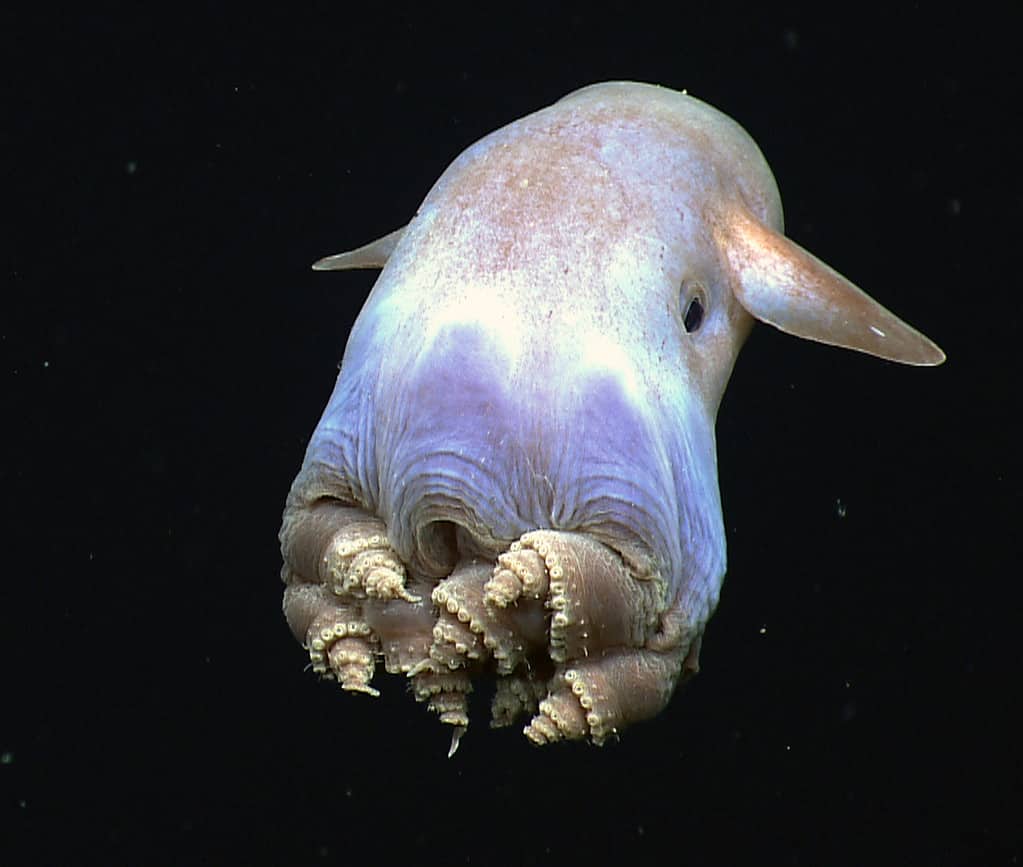
A dumbo octopus uses his ear-like fins to slowly swim away – this coiled leg body posture has never been observed before in this species.
©NOAA Okeanos Explorer, Public domain – License
The dumbo octopus (Grimpoteuthis) gets its name from Disney’s famous character due to its large fins that resemble the elephant’s ears. While the average dumbo octopus measures between 7.9-12 inches long, some can grow to be much larger. The largest recorded specimen was 5 feet, 10 inches long, and weighed almost 13 pounds. In total, there are more than 15 species of dumbo octopus. They are the deepest-dwelling octopus, living at depths of at least 13,100 feet, which makes sightings extremely rare. Additionally, they are one of the few species of octopus that do not have an ink sac, as they have few natural predators. The IUCN currently lists dumbo octopus as a species of Least Concern.
#9: Southern Red Octopus
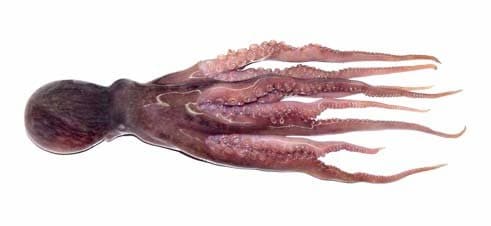
This octopus is native to the coasts of Chile and Argentina, where they are one of the most abundant species of octopus.
©Bortolus et al. (2006), CC BY-SA 4.0 – License
Also known as the Patagonian red octopus, the southern red octopus (Enteroctopus megalocyathus) is part of the genus Enteroctopus or giant octopus. Although they are not as massive as other species of Enteroctopus, the southern red octopus can still reach impressive sizes. Their average weight is 8.8 lb, and they usually measure around 3.3 feet in length. Southern red octopuses are distinguishable by their striking red color and paddle-shaped papillae. They are native to the coasts of Chile and Argentina, where they are one of the most abundant species of octopus. Currently, the IUCN has yet to evaluate the status of the southern red octopus.
#8: Yellow Octopus
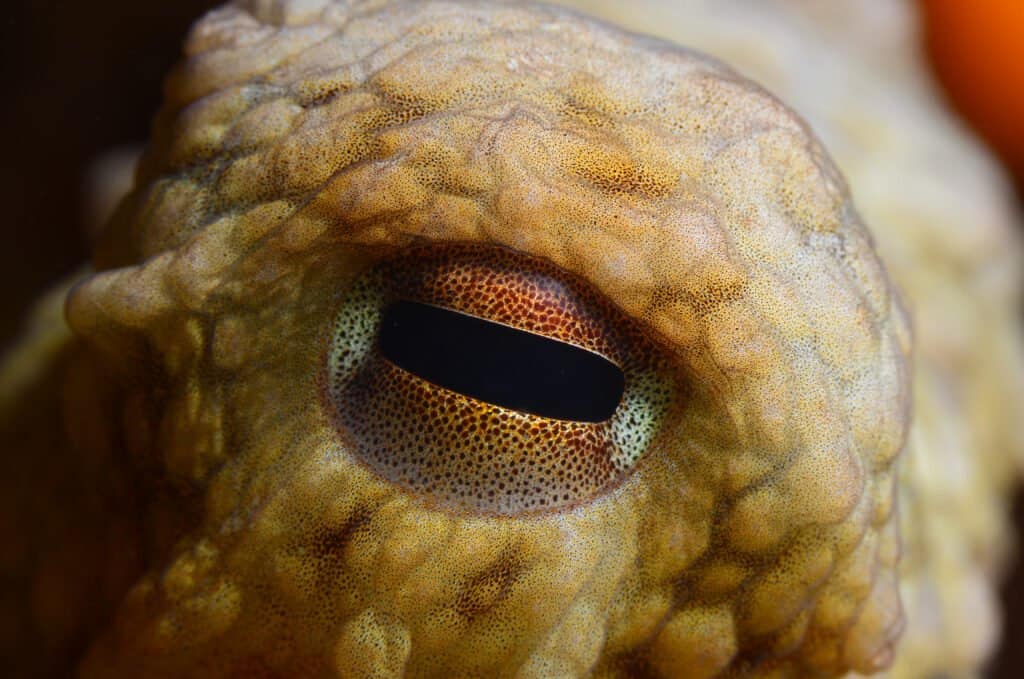
Yellow octopus live off the southeast coast of New Zealand
©Osman Temizel/Shutterstock.com
The yellow octopus (Enteroctopus zealandicus) is another member of the genus Enteroctopus. Little information exists about these mysterious creatures, so scientists must estimate how big they can grow. To date, the largest yellow octopus weighed 11 pounds and measured 4.6 feet in length. Yellow octopuses live in the waters surrounding New Zealand, and although they are abundant, few specimens have ever been recovered.
This is due to their penchant for dwelling far below the surface – not to mention a relative lack of interest in them on the part of regional fisheries.
They are, however, the object of interest of sea lions and whales in the region which are not averse to having them on the menu.
What has been observed about yellow octopuses so far? Their penchant for littering their surroundings with leftovers of their favorite foods.
Now marine scientists have taken greater interest in these mollusks, (admittedly to discover the cause of declining sea lion populations in the region), it is hoped they might be able to shed some more light on the habits of these elusive creatures.
As of yet, the IUCN has not evaluated the status of the yellow octopus.
#7: Mimic Octopus
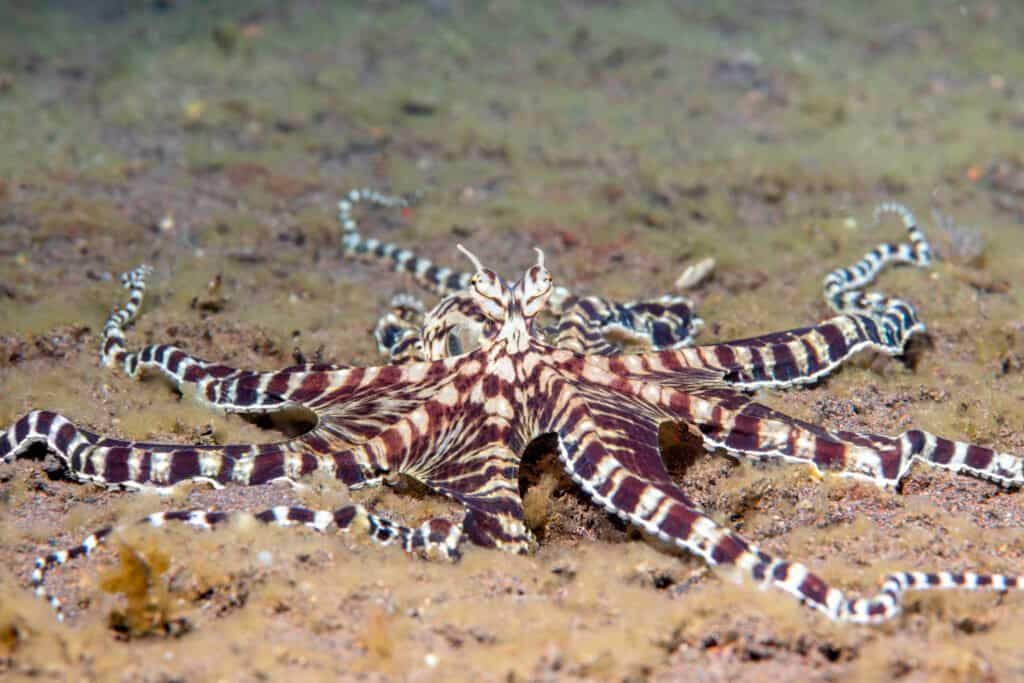
Female mimic octopus can reach three times the size of males!
©Joe Belanger/Shutterstock.com
The mimic octopus (Thaumoctopus mimicus) is one of the most extraordinary varieties of octopus in the ocean. They are sexually dimorphic, as the females are much larger than the males. While males typically weigh between 5-6 lb, females can easily weigh up to 20 pounds. The average length of a mimic octopus is 2 feet, although they may be longer. Many species can camouflage their bodies, but mimic octopuses are experts at taking on the appearance of other animals and blending with their environment. They range from the Red Sea to New Caledonia and between the Gulf of Thailand and the Great Barrier Reef. To date, the IUCN has not evaluated the status of the mimic octopus.
#6: Common Octopus
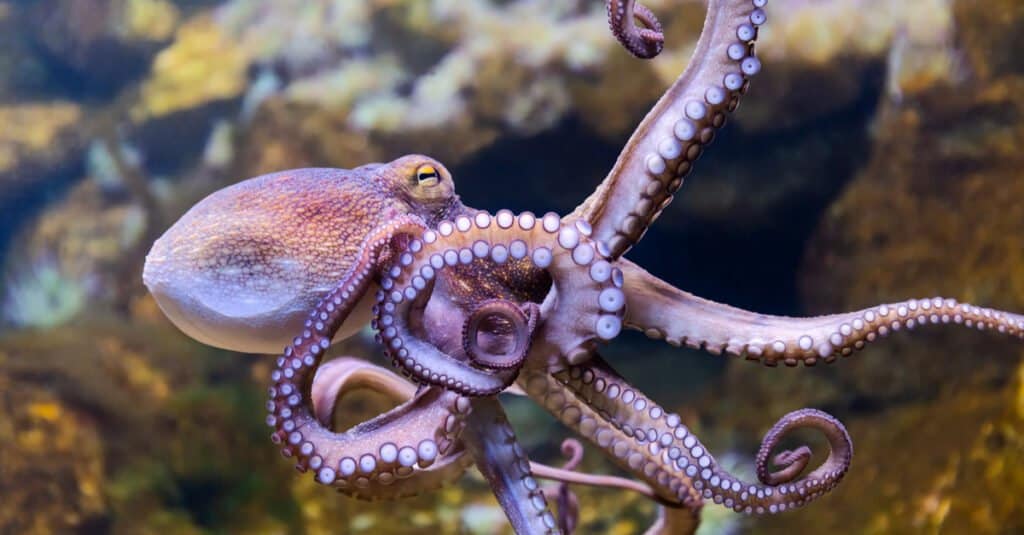
In a surprising show of forethought, an octopus can plan ahead.
©Henner Damke/Shutterstock.com
In addition to being one of the largest known species, the common octopus (Octopus vulgaris) is also among the most well-studied. Weights and lengths can vary, but they typically measure between 6.6-22 lb and 1-3 feet in length. They are abundant and can be found all over the globe. Their preferred foods include crabs, crayfish, and mollusks, but they are not picky eaters. Like all octopuses, they have three hearts and large, advanced nervous systems and brains. While common octopuses reside in all temperatures of waters, they congregate in relatively shallow, rocky areas near coasts. The IUCN lists the common octopus as a species of Least Concern.
#5: Southern Giant Octopus
Similar to other members of the genus Enteroctopus, the southern giant octopus (Enteroctopus magnificus) is known for its distinctive size. Specimens typically weigh around 25 lbs and can measure up to 6 feet in length. They are native to the waters off the coasts of Namibia and South Africa and tend to enjoy spending time in shallow, subtidal areas. Southern giant octopuses hunt a wide variety of prey, but their diet primarily consists of deep-sea portunid crab. The IUCN has not yet evaluated the status of the southern giant octopus, although harvests by fisheries are generally small.
#4: Maori Octopus

They eye of a Maori octopus
©Iman Daniel/Shutterstock.com
Also known as the New Zealand octopus, the Maori octopus (Macroctopus maorum) is just slightly larger than the southern giant octopus. On average, they weigh between 22-26.5 lb and measure from 3.3-6.5 feet in length. Maori octopuses are famously aggressive, even compared to other species of octopus. Females can lay up to 7000 eggs at a time and will fiercely protect their spawn from predators. They are predominantly located in the waters surrounding South Australia and New Zealand. Currently, the IUCN has not evaluated the status of the Maori octopus, although the population appears to be stable based upon catch records.
#3: Frilled Giant Pacific Octopus
Discovered in 2017, the frilled giant Pacific octopus (Enteroctopus dofleini) is a close relative of the giant Pacific octopus. Frilled giant Pacific octopuses are distinguishable from their sister species thanks to a frill of merged papillae across their bodies along with two white spots on their heads. Little information is available about their average size, but biologists estimate that they can reach up to 110 lb and 16 feet in length. They can be found around Prince William Sound on the south coast of Alaska. Due to its recent discovery, the IUCN has yet to evaluate the frilled giant Pacific octopus’s status.
#2: Seven-Arm Octopus
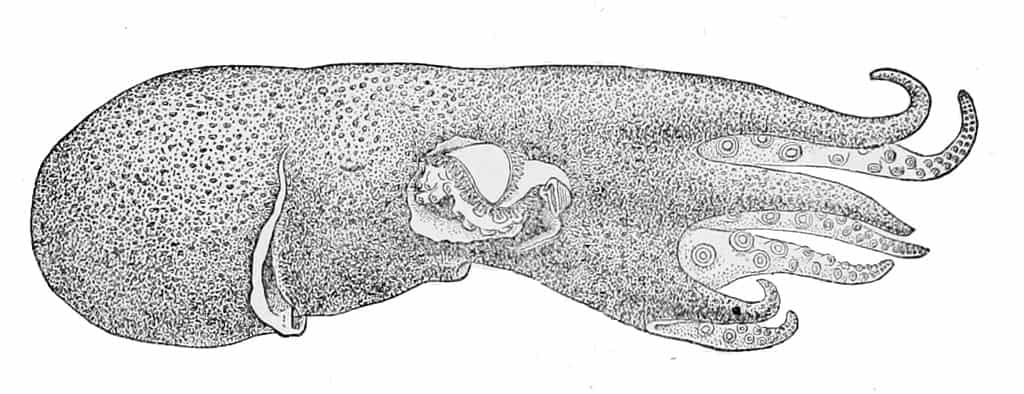
©A.E Verrill (Addison Emery), 1839-1926;/Public domain – License
Although its name is somewhat misleading, the seven-arm octopus (Haliphron atlanticus) has eight arms like all other species of octopus. Their name comes from the unique arm used for egg fertilization by males of the species coiled in a sac beneath the right eye. Amongst known octopuses, they are second only to the giant Pacific octopus in terms of size. They can reach a maximum weight of 165 lb and lengths of around 11 feet. The majority of specimens originated from the Atlantic Ocean, but rare sightings have occurred in the South Pacific. The IUCN lists the seven-arm octopus as a species of Least Concern.
#1: Giant Pacific Octopus

A close up of a giant Pacific octopus
©karen crewe/Shutterstock.com
The giant Pacific octopus (Enteroctopus dofleini) is the largest species of octopus in the world. They typically weigh around 150 lb and measure over 15 feet long. However, the largest specimen on record weighed almost 600 lb and measured 30 feet in length. Their diet consists of clams, shrimp, crabs, abalone, snails, scallops, fish, lobsters, and even other octopuses. On occasion, Giant Pacific octopuses will even prey upon small sharks, such as the spiny dogfish. Sightings usually occur in waters bordering the western United States, British Columbia, Alaska, Japan, Russia, and the Korean Peninsula. The population of giant Pacific octopuses is unknown, and the IUCN currently lists them as a species of Least Concern.
Summary of the 10 Largest Octopuses in the World
| Number | Name | Weight | Length |
| 1 | Giant Pacific Octopus | 150 lbs | Over 15 feet |
| 2 | Seven-Arm Octopus | 165 lbs | 11 feet |
| 3 | Frilled Giant Pacific Octopus | 110 lbs | 16 feet |
| 4 | Maori Octopus | 22 – 26.5 lbs | 3.3 – 6.5 feet |
| 5 | Southern Giant Octopus | 25 lbs | 6 feet |
| 6 | Common Octopus | 6.6 – 22 lbs | 1-3 feet |
| 7 | Mimic Octopus | 5 – 6 lbs | 2 feet |
| 8 | Yellow Octopus | 11 lbs | 4.6 feet |
| 9 | Southern Red Octopus | 8.8 lbs | 3.3 feet |
| 10 | Dumbo Octopus | 13 lbs | 7.9 – 12 inches |
The photo featured at the top of this post is © Vladimir Wrangel/Shutterstock.com
Thank you for reading! Have some feedback for us? Contact the AZ Animals editorial team.



